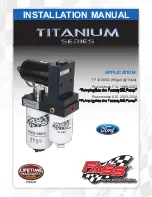
Note:
During each shift, the clutch pedal must be fully pressed to the
floor and the accelerator fully released. Failure to follow this may cause
increased shift efforts, prematurely wear transmission components, or
cause gear clash or damage to the transmission. Make sure the floor mat
is properly positioned so it doesn’t interfere with the full extension of the
clutch pedal.
Note:
If you attempt to shift when the drive wheels are spinning with a
loss of traction, it is possible to cause damage to the transmission. Do
not attempt to shift when the drive wheels do not have traction.
Do not drive with your foot resting on the clutch pedal or use the clutch
pedal to hold your vehicle at a standstill while waiting on a hill. These
actions will reduce the life of the clutch.
Your vehicle is equipped with a twin disc clutch. Due to the high
performance of the powertrain, a certain amount of noise from the
transmission is normal.
Clutch Protection
Your vehicle is equipped with an electronic powertrain feature to reduce
clutch damage. When excessive clutch slip is detected at a high power
level, the powertrain control module will limit torque to reduce damage
to the clutch. Full power is restored as soon as the clutch is fully
engaged. This feature is calibrated in a way that does not interfere with
normal driving and does not impede maximum acceleration capability.
Recommended Shift Speeds for Maximum Fuel Economy
Upshift according to the following chart:
Upshifts when accelerating
Shift from:
1 - 2
11 mph (18 km/h)
2 - 3
18 mph (29 km/h)
3 - 4
25 mph (40 km/h)
4 - 5
30 mph (48 km/h)
5 - 6
43 mph (69 km/h)
Driving your Shelby® GT500®
13
2014 05+ Mustang
(197)
Supplement, 1st Printing, December 2012
USA
(fus)















































